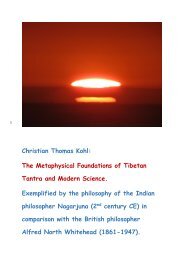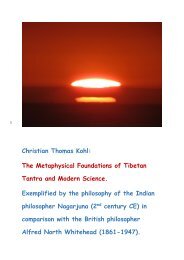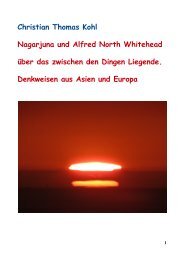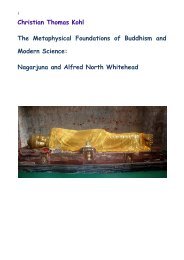Christian Thomas Kohl The Metaphysical Foundations of Buddhism and Modern Science
Christian Thomas Kohl The Metaphysical Foundations of Buddhism and Modern Science
Christian Thomas Kohl The Metaphysical Foundations of Buddhism and Modern Science
Create successful ePaper yourself
Turn your PDF publications into a flip-book with our unique Google optimized e-Paper software.
ideas <strong>of</strong> substance or subject, two main metaphysical traditions <strong>of</strong> European<br />
philosophical history, two main principles. <strong>The</strong>se substances <strong>and</strong> these subjects<br />
are two immaterial bodies which were considered by traditional European<br />
metaphysics as lying, as a sort <strong>of</strong> core, inside the objects or underlying the<br />
empirical reality <strong>of</strong> our world. <strong>The</strong> first European scientist who saw with his<br />
inner eye the forces between two things had been Michael Faraday (1791-<br />
1867). Faraday was an English scientist who contributed to the fields <strong>of</strong><br />
electromagnetism. Later physicists like Albert Einstein, Niels Bohr, Erwin<br />
Schrödinger, Werner Heisenberg <strong>and</strong> others followed his view in modern<br />
physics. This is a fifth point <strong>of</strong> my work. I compare Nagarjuna with European<br />
scientific modes <strong>of</strong> thought for a better underst<strong>and</strong>ing <strong>of</strong> Asia. I do not<br />
compare Nagarjuna with European philosophers like Hegel, Heidegger,<br />
Wittgenstein. <strong>The</strong> principles <strong>and</strong> metaphysical foundations <strong>of</strong> physical sciences<br />
are more representative for European modes <strong>of</strong> thought than the ideas <strong>of</strong><br />
Hegel, Heidegger <strong>and</strong> Wittgenstein <strong>and</strong> they are more precise. And slowly we<br />
are beginning to underst<strong>and</strong> these principles.<br />
Let me take as an example the interpretation <strong>of</strong> quantum entanglement by the<br />
British mathematician Roger Penrose. Penrose discusses in the year <strong>of</strong> 2000<br />
the experiences <strong>of</strong> quantum entanglement where light is separated over a<br />
distance <strong>of</strong> 100 kilometers <strong>and</strong> still remains connected in an unknown way.<br />
<strong>The</strong>se are well known experiments in the last 30 years. Very strange for<br />
European modes <strong>of</strong> thought. <strong>The</strong> light should be either separated or<br />
connected. That is the expectation most European modes <strong>of</strong> thought tell us.<br />
Aristotle had been the first. Aristotle (384 - 322 Before Current Era) was a<br />
Greek philosopher, a student <strong>of</strong> Plato <strong>and</strong> a teacher <strong>of</strong> Alex<strong>and</strong>er the Great.


















